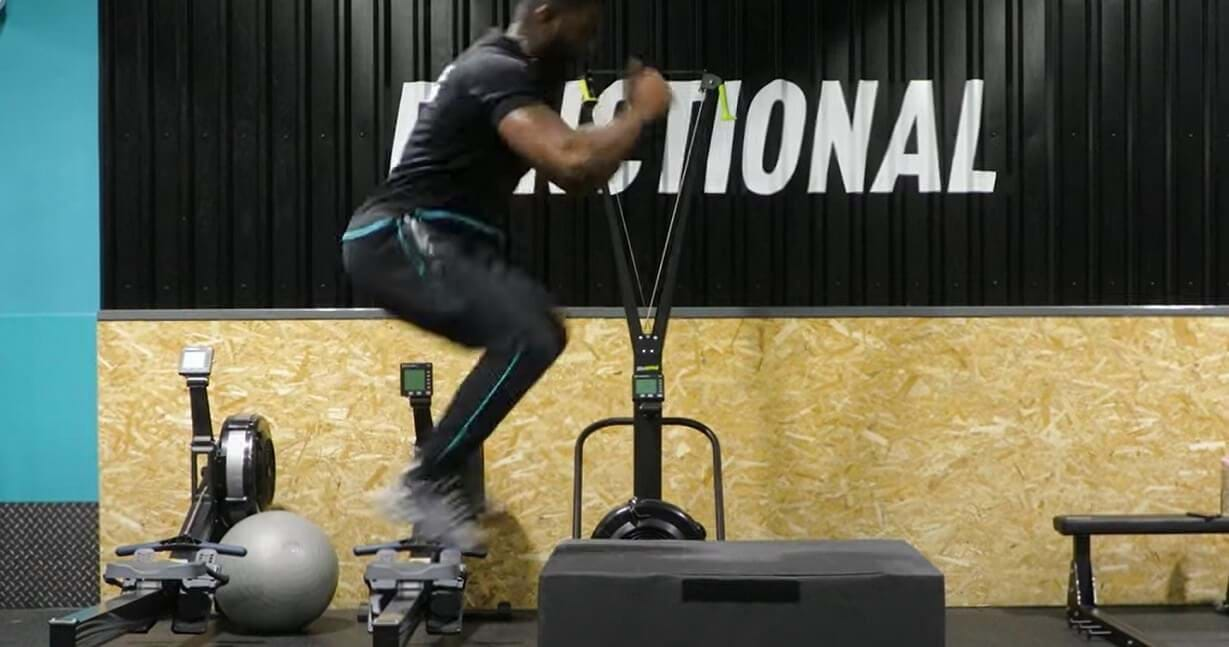Box Jumps
What are Box Jumps?

Box jumps are a dynamic cardio exercise that involves jumping onto a raised surface with both feet taking off and landing together. Box jumps strengthen the quads, hamstrings, glutes, calves, and core muscles while raising the heart rate and burning calories. They help build power, improve athletic performance, and train the triple extension movement that is needed for Olympic weightlifting.
Plyometric exercises like box jumps have three phases - the eccentric phase where the muscle lengthens while under tension, the amortisation or pause between stretching and contracting, and the concentric phase of explosive muscle contraction. The quick transition between stretching and contracting the muscles helps develop power.
Box jumps are traditionally done on a plyometric box but can be modified by jumping onto a lower surface to help you build technique and power. When performing box jumps, hinge at your hips and swing your arms back, then jump up onto the box, landing softly with both feet. Step down rather than jumping down to reduce impact.
Box jumps require a foundation of lower body strength and proper jumping mechanics. Beginners could start with box step-ups and squat jumps before moving onto a low box. Try adding box jumps to your gym cardio routine, HIIT workouts, or as a short finisher after leg training. Start with 2-3 sets of 5-8 repetitions, focusing on quality of movement.
Take a look at our technique tips and demo video for box jumps below.
Check out some other jump exercises: Tuck Jumps, Pike Jumps, Lateral Jumps, Broad Jumps
Commonly Asked Questions About Box Jumps
Box jumps develop explosive power and muscle strength in the lower body while building neuromuscular coordination. They train your fast-twitch muscle fibres and build power through triple extension of the ankles, knees, and hips. Box jumps also boost cardio fitness, burn calories, and build confidence in your jumping ability.
Yes, box jumps are a classic plyometric exercise that work the stretch-shortening cycle of muscles. Plyometric movements involve rapid muscle lengthening followed by explosive contraction, training the nervous system to produce force. Box jumps specifically develop lower body power.
Box jumps mostly work the muscles of the lower body, including the quads, hamstrings, glutes, and calves during the explosive jumping phase. The core muscles, including rectus abdominis and obliques, stabilise the trunk throughout the movement. Your hip flexors will work to lift your legs, and your shoulders and arms will assist with momentum. Landing on the box and stepping back down requires additional stabilisation from smaller muscles in the ankles, feet, and knees.
Box jumps require lower body strength, fitness, and confidence. Start with foundational exercises like squat jumps, step-ups, and landing mechanics practice. To begin with, use a lower box height (12-18 inches) and master proper landing technique before increasing your box height. Incorporate exercises like squats and lunges to build lower body strength. warm up thoroughly and progress gradually to prevent injury.
Box Jump Tips
- Practice jumping onto a low box to build power and confidence.
- Land with soft knees and stand up once stable on the box.
- Step backwards off the box carefully, don't jump down.
How To Do Box Jumps
Face the box about 3-6 inches away (the higher the box, the further away you’ll need to stand).
Bend your knees, sink into a slight squat, and swing your arms behind you.
Explode up jumping up off both feet while swinging your arms to propel you forward.
Tuck your knees towards your chest to clear the height of the box.
Land on the box on the balls of both feet, allowing the heels to follow naturally.
Push through the heels to stand up, then step back off the box onto the floor.
Repeat for desired reps.
If you’re not sure if any of the above exercises are suitable for you, please consult your doctor before you start it. Need guidance on how to perform the exercise? Ask a personal trainer at your gym.